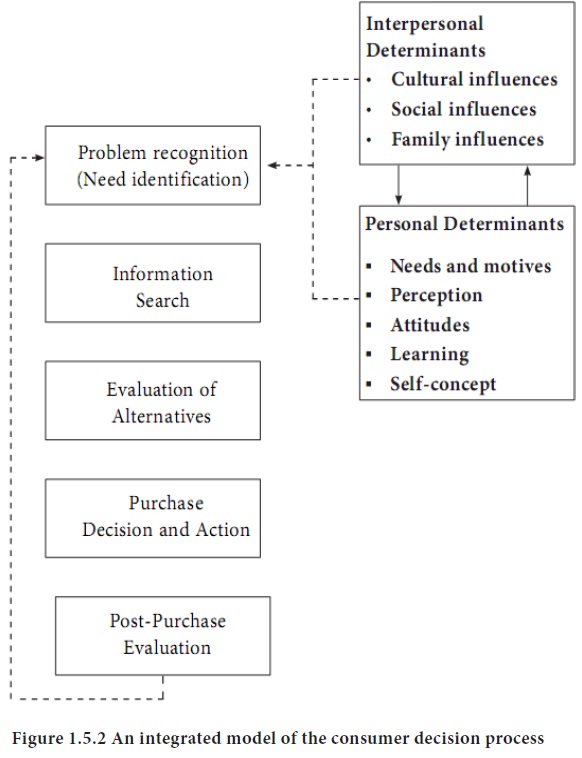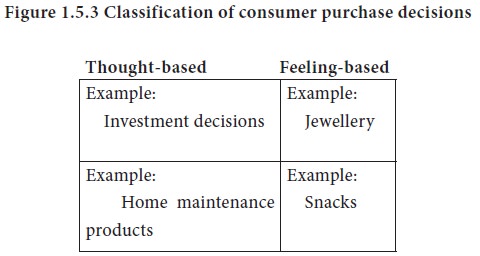MARKETING MANAGEMENT - Buyer Behaviour
The Consumer Decision Process - Buyer Behaviour
Posted On :
Consumers complete a step-by-step process to make purchasing decisions.
The Consumer Decision Process

Consumers complete a step-by-step process to make purchasing decisions. The length of time and the amount of effort they devote to a particular purchasing decision depends on the importance of the desired good or service to the consumer.
Purchases with high levels of potential social or economic consequences are said to be high-involvement purchase decisions. Routine purchases that pose little risk to the consumer are low-involvement decisions. Consumer generally invest more time and effort to purchase decisions for high-involvement products than to those for low-involvement products.
For example, a car buyer will probably compare prices, spend time visiting dealer showrooms, read auto reviews and ask for advice from friends before making the final decision.
Few buyers invest that much effort in choosing between two brands of candies. They will still go through the steps of the consumer decision process but on a more compressed scale. Purchase decisions can be thought-based (cognitive) or feeling-based (emotive). While it is true that both cognition and emotion will be present in every purchase decision, either one of them will dominate the decision. As a result, we can construct a grid as follows to analyze different consumer purchase decisions.

Figure 1.5.2 shows the five steps in the consumer decision process.
During the first stage in the consumer decision making process, the consumer becomes aware of the discrepancy between the actual state (‘where we are now’ and the ideal state (‘where we want to be’). Problem recognition motivates the individual to achieve the desired state of affairs. A marketer can stimulate problem recognition either by creating a new ideal state or by creating dissatisfaction with the actual state.
In the second stage, the consumer gathers information related to his/her attainment of a desired state of affairs. This search identifies alternative means of problem solution. High-involvement purchases may elicit extensive information searches, while low-involvement purchases require little search activity. The search may cover internal or external sources of information. During internal search, stored information, feelings and experiences relevant to the problem-solving situation are recalled from the consumer’s memory. An external search gathers information from outside sources, which may include family members, associates, store displays, sales representatives, advertisements and product reviews. The external search may be a general on-going search or a specific pre-purchase search. The search identifies alternative brands for consideration and possible purchase. The number of brands that a consumer actually considers in making a purchase decision is known as the evoked set. Marketers try to influence consumer decisions during the search process by providing persuasive information about their goods or services in a format useful to consumers.
The third step in the consumer decision making process is to evaluate the evoked set of options identified during the search step. The outcome of the evaluation stage is the choice of a brand or product in the evoked set or possibly a decision to renew the search for additional alternatives, should all those identified during the initial search prove unsatisfactory. To complete this analysis, the consumers develop a set of evaluative criteria to guide the selection. These criteria can either be objective facts or subjective impressions. Marketers can attempt to
The search and alternative evaluation stages of the decision process result in the eventual purchase decision and the act of making the purchase. At this stage, the consumer has evaluated each alternative in the evoked set based on his/her personal set of evaluative criteria and narrowed the alternatives down to one. Marketers can smooth the purchase decision and action by helping consumers through financing, delivery, installation and so on.
The purchase act produces one of two results.
The buyer feels either satisfaction at the removal of the discrepancy between the actual and the ideal states or dissatisfaction with the purchase. Consumers are generally satisfied if purchases meet their expectations.
Sometimes, however, consumers experience some post purchase anxieties, called cognitive dissonance. It is a perception that one has not made the right decision. The consumer attempts to reduce this dissonance by searching for additional information that confirms his/her choice. The marketer can help by providing reassuring information to the buyer and also by positive marketing communications.

Consumers complete a step-by-step process to make purchasing decisions. The length of time and the amount of effort they devote to a particular purchasing decision depends on the importance of the desired good or service to the consumer.
Purchases with high levels of potential social or economic consequences are said to be high-involvement purchase decisions. Routine purchases that pose little risk to the consumer are low-involvement decisions. Consumer generally invest more time and effort to purchase decisions for high-involvement products than to those for low-involvement products.
For example, a car buyer will probably compare prices, spend time visiting dealer showrooms, read auto reviews and ask for advice from friends before making the final decision.
Few buyers invest that much effort in choosing between two brands of candies. They will still go through the steps of the consumer decision process but on a more compressed scale. Purchase decisions can be thought-based (cognitive) or feeling-based (emotive). While it is true that both cognition and emotion will be present in every purchase decision, either one of them will dominate the decision. As a result, we can construct a grid as follows to analyze different consumer purchase decisions.

Figure 1.5.2 shows the five steps in the consumer decision process.
1.Problem recognition
During the first stage in the consumer decision making process, the consumer becomes aware of the discrepancy between the actual state (‘where we are now’ and the ideal state (‘where we want to be’). Problem recognition motivates the individual to achieve the desired state of affairs. A marketer can stimulate problem recognition either by creating a new ideal state or by creating dissatisfaction with the actual state.
2. Information search
In the second stage, the consumer gathers information related to his/her attainment of a desired state of affairs. This search identifies alternative means of problem solution. High-involvement purchases may elicit extensive information searches, while low-involvement purchases require little search activity. The search may cover internal or external sources of information. During internal search, stored information, feelings and experiences relevant to the problem-solving situation are recalled from the consumer’s memory. An external search gathers information from outside sources, which may include family members, associates, store displays, sales representatives, advertisements and product reviews. The external search may be a general on-going search or a specific pre-purchase search. The search identifies alternative brands for consideration and possible purchase. The number of brands that a consumer actually considers in making a purchase decision is known as the evoked set. Marketers try to influence consumer decisions during the search process by providing persuasive information about their goods or services in a format useful to consumers.
3. Evaluation of alternatives
The third step in the consumer decision making process is to evaluate the evoked set of options identified during the search step. The outcome of the evaluation stage is the choice of a brand or product in the evoked set or possibly a decision to renew the search for additional alternatives, should all those identified during the initial search prove unsatisfactory. To complete this analysis, the consumers develop a set of evaluative criteria to guide the selection. These criteria can either be objective facts or subjective impressions. Marketers can attempt to
4. Purchase Decision and Action
The search and alternative evaluation stages of the decision process result in the eventual purchase decision and the act of making the purchase. At this stage, the consumer has evaluated each alternative in the evoked set based on his/her personal set of evaluative criteria and narrowed the alternatives down to one. Marketers can smooth the purchase decision and action by helping consumers through financing, delivery, installation and so on.
5. Post-Purchase Evaluation
The purchase act produces one of two results.
Satisfaction
The buyer feels either satisfaction at the removal of the discrepancy between the actual and the ideal states or dissatisfaction with the purchase. Consumers are generally satisfied if purchases meet their expectations.
Dissatisfaction
Sometimes, however, consumers experience some post purchase anxieties, called cognitive dissonance. It is a perception that one has not made the right decision. The consumer attempts to reduce this dissonance by searching for additional information that confirms his/her choice. The marketer can help by providing reassuring information to the buyer and also by positive marketing communications.
Tags : MARKETING MANAGEMENT - Buyer Behaviour
Last 30 days 652 views












